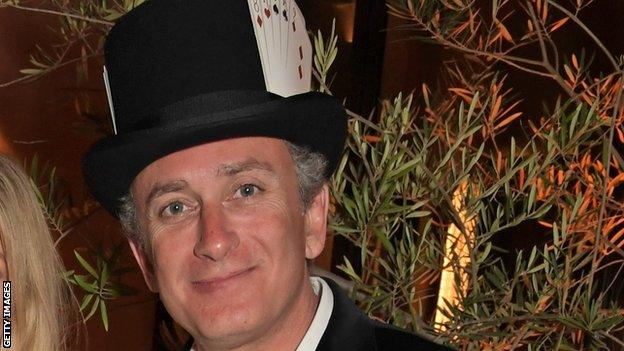Extreme E: How motorsport's modern-day Spanish explorer plans to change the way we race
- Published

Race one of the new Extreme E series will be broadcast live from Al Ula, Saudi Arabia, on 3-4 April
EXTREME-E ROUND 1 AL-ULA SAUDI ARABIA | |||
|---|---|---|---|
Date | Session | Time | Coverage |
Saturday, 3 April | Qualifying 1 & Qualifying 2 | 07:00-08:30 BST & 12:00-13:30 BST | On iPlayer, BBC Sport website and Red Button |
Sunday, 4 April | Semi-final & Crazy race, Final | 07:00-08:30 BST & 11:00-13:00 BST | On iPlayer, BBC Sport website and Red Button (Final not on Red Button) |
This weekend a sport kicked off its first event with an aim like no other, at a time like no other.
A motorsport with a conscience, which aims to raise awareness and act upon climate change and equality, using an equal split of men and women racing off-road 'electric SUVs' in remote areas of the globe which have been affected by global warming.
Instead of the presence of crowds, a team of scientists will research, raise awareness and head legacy projects wherever they go.
But for a sport with such futuristic, progressive aims at its core, the start of Extreme E's adventure has a very old-world feel to it…
'The heart and soul of Extreme E'
The desolate, eerie quiet of rusty heavy industry combined with deep, dark water is the fabric of Birkenhead docks.
But one ship stands out in docking bay two: the St Helena - an imposing and unusually liveried boat central to a hive of activity.
Racing cars are being winched into the open loading bay beneath the ship's huge bridge, as forklifts chug and steel loading hooks clatter against more steel, as men shout, "woah!"
Among these men, and women, stands series chief executive and co-founder Alejandro Agag. A 50-year-old macro-scale businessman from Spain, he's here on the ground watching every car loaded and every curtain rail screwed into position.
"She's amazing isn't she - I love this ship. I've been staying on it," says Agag, watching on wide-eyed in hard hat and high-vis jacket - a modern equivalent to the top hat and tails of the Spanish explorers of old.
"And this is a big moment - I just had a vision of [the loader] flipping over and the car just crashing back on to the ground."

St Helena is Extreme E's 'floating paddock', designed to transport almost all of the sport's equipment from one race to another. Cars, battery-charging equipment, broadcast gear… everything but the drivers.
Not to mention the 62 cabins for everyone who will keep it all moving.
"St Helena is the soul of Extreme E," says Agag, with passion in his voice. "It used to serve the people of the island of St Helena [situated in the South Atlantic Ocean, between the west coast of Africa and Brazil], when they didn't have an airport. People were actually born on it."
How it made it into the hands of Agag has an altogether darker, more intriguing, edge. "It was used by the security people who protected big freight and cruise vessels from Somali pirates," say Agag of Helena's former life in the Indian Ocean, housing the guns and other means of protection used in the murky world of the security mercenary.
"She was in such a state when we bought her," he adds, wincing when asked if he is willing to reveal how much it cost to bring it up to a standard, to host to the likes of Lewis Hamilton and some of the world's most highly regarded scientific minds.
He doesn't divulge exactly, but it is in the millions. "We had to rip everything out and start again."
On board there are a bars, kitted out with commissioned artwork on the walls and a restaurant serving fine food and wine all ready to go.
Even as painters and decorators add a final lick to the cabins and the sinks are plumbed into the scientists' laboratory, the kitchen is knocking out fine rare steak and sautéed mushrooms, testing out the dining on whoever is passing by.
And there are plenty of people passing by. Yuri, the surly Finnish captain has a voyage through the Mediterranean and Suez Canal to prepare.
Izy tests the DJ booth and speakers in the Blue Parrot lounge for quality; the roof panel which promptly falls on to her head as a result of the bass, confirms everything is in order.
Catie Munnings, a driver for the British-American United Andretti team is on deck too. Looking for where some of her promotional work is supposed to be taking place. "This championship is massive for females in motorsport," says Munnings, 23.
"We want them to get into it when they're young to give them a chance to be as successful as their male counterparts are."
The future of motorsport is electric - Button
How sport sits alongside science
All global sports - motorsport in particular - rely upon substantial sea and air freight to keep the show on the road. So Helena is the first visual representation of doing things differently.
In F1, for example, 45% of the 256,000 tonnes of carbon produced for the entire 2019 season was on logistics alone. For Extreme E, its total carbon tonnage for 2021 is estimated to be 20,000 - for fewer races - which they have pledged to offset.
Both sports have ambitious carbon neutrality targets, but new approaches, such as using a ship, are already making a difference.
But behind the equality and climate patter, there's plenty of excitement for the fans, if the lap times from the secretive testing sessions are anything to go by.
"Some of the female drivers were faster than much more experienced male drivers on paper," said one team member. "So it could be really exciting."
And they are not messing about with the line-up, which includes 2009 F1 world champion Jenson Button - who has his own JBXE team - and nine-time world rally champion Sebastien Loeb, who will drive for Lewis Hamilton's X44 squad.
But a key point of Extreme E is the reach for equality that will one day mean female drivers - such as Veloce's Jamie Chadwick and Munnings herself - could be listed as legends in the same way the men are.

One of Agag's favourite phrases adorns stairwell of St Helena
It's just a question of how well sport sits alongside science. Several scientists, including the University of Cambridge's Professor Peter Wadhams, will be looking to make as much of an impression on the audience as the drivers and teams.
The scientists' lab, for example, will draw sea water up from the bow as she is on the move. Even the route to Saudi Arabia is of interest to scientists.
"They have never taken this route to Saudi before, so this gives them crucial data on the water as she makes her way," says Agag over a gorgonzola and walnut salad and glass of red.
"It's a passion project, there have been many challenges, but the sense of adventure is what is special. We need to affect change, and people need to be interested in the way that is done."
Agag is no stranger to adventure, or doing things his own way. During his national service in the Spanish army he would avoid drinking in bars during down time with his fellow soldiers, opting instead for a luxury hotel and a laptop to indulge his passion: politics. A successful career as an MEP and subsequently in business followed.
"I don't care if people think that what we are doing is just a publicity stunt," says Agag. "People who don't take action and just criticise, they are free to do that. I just don't listen.
"There's no good or bad guys in climate action - everyone has a role to play. Everybody needs to do something now."
Now, Helena is in Jeddah in Saudi Arabia, having made it through the Suez Canal, mercifully, before the Ever Given blockage.
If Extreme E's first race created as many memes and retweets across social media as a boat that got stuck in some mud, then it might just all be worth it.
New Extreme E climate-aware SUV unleashed

Obsessed with Line of Duty: Listen to reactions and predictions as the series unfolds
Evil Genius?: Diego Maradona's ability to delight and despair is debated on the show
